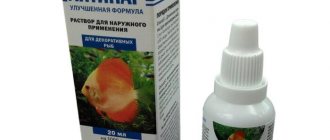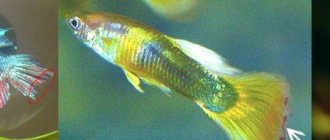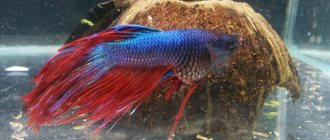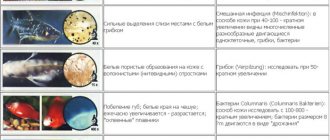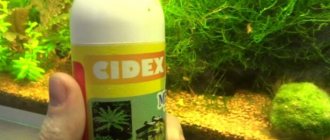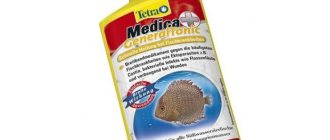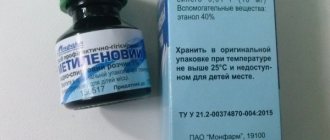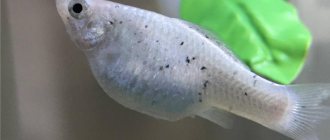The appearance of signs such as bulging eyes, lack of appetite or bloating of the abdomen may indicate the appearance of illness in the fish. In such cases, effective antibacterial drugs are needed, which include Sera baktopur. The product effectively fights external and internal bacteria without harming the health of aquarium inhabitants. Sera baktopur can be used for both freshwater and marine aquariums . More details about the use of the antibacterial drug Sera baktopur will be discussed in this article.
sera baktopur
Fin rot
We talk about medicine, but we avoid mentioning diseases, and this is wrong. Readers should be able to distinguish the appearance of a particular disease by external signs.
Let's start our story with one of the most common diseases among aquarium inhabitants. It is called fin rot, and “Sulfur Baktopur” successfully copes with the symptoms of this disease.
What is fin rot? A bluish-white coating appears on the edges of the tail and fins. The ends of the fins look like they have been plucked off. And if the spread of the disease is not prevented, it will cover the entire body of the fish.
Sometimes you can see red stripes or spots appear on the fins. This is a type of rot, then these stripes will turn into ulcers.
A characteristic feature of the disease is clouding of the eyeballs in fish.
Indications for use
The drug is an antibacterial agent that is designed to fight most types of bacteria in freshwater aquarium fish. Suitable for the treatment of columnar blight, gill and fin rot, as well as typical bacterial diseases.
Bacterial infections of fish can manifest themselves in the form of whitish or grayish spots on the body and fins. The edges of the fins may be inflamed. Swelling and inflamed areas appear on the skin of scaly pets. Bleeding from the anus may also occur.
Infectious diseases of fish can be accompanied by bloating and dropsy, when the cavity inside the body is filled with watery fluid. At the same time, small pets’ eyes often bulge, and their scales begin to become very puffy.
Find out what to do if your fish die in your aquarium.
You may also notice bruising on the skin and cotton-like fuzz around the mouth, and greyish-whitish pustules appearing on the fins and scales. Fins can sometimes be completely destroyed by an infectious lesion.
All such manifestations are symptoms of a developing bacterial infection in your scaly pets. In addition to external physiological signs, the fish also experience psychological changes - they become very excited, often behave restlessly, and try to stay closer to the bottom of the aquarium.
The drug is also suitable for treating affected areas against external parasites - fish leeches and lice, as well as crustacean parasites on the gills of fish.
Ichthyophthiriasis
Ichthyophthiriasis - white spots on fish, accompanied by a sharp deterioration in the condition of underwater inhabitants. The body of the fish is covered with a uniform white coating, similar in appearance to semolina flour. And the pets themselves become lethargic, refuse to eat and gasp for air. It looks like the fish is suffocating in the water.
Ichthyophthiriasis is treated with the help of “Sera Baktopur”. It must be borne in mind that the disease progresses quickly, and the use of medicine is necessary as soon as the owner notices changes in the behavior and appearance of the fish.
Lepidorthosis
The second name for this disease is ruffled scales. The most susceptible to it are very young individuals, as well as fish that have not undergone quarantine after acquisition. Not only will they catch the infection themselves, but they will also infect the entire aquarium.
If you do not intervene in time with treatment, then sick fish are doomed to death. Therefore, as soon as the owner notices signs of the onset of the disease, he urgently goes to the store, buys “Sera Baktopur”, and begins a course of treatment.
What symptoms visible to the human eye indicate a disease? These include:
- First, scales rise in some places on the fish’s body. The aquarium resident herself becomes restless, she rubs herself against the stones and soil, because the itching is very annoying.
- The disease progresses slowly, the more severe its form, the more scales fall out. Ultimately, it almost completely dies off, the fish lose their bodily covering and die.
Dropsy
This disease affects not only people and animals, but also fish. It is not always contagious to the rest of the aquarium inhabitants if it is found in one of them. But it’s not worth the risk; it is advisable to place the patient in a separate tank, and clean the main aquarium for preventive purposes, change the water and rinse the equipment. The “patient” is treated with “Sera Baktopur”.
The main signs of dropsy:
- The fish has a swollen belly, just do not confuse the disease with banal overfeeding or pregnancy.
- The aquarium inhabitant has rapid breathing, which can be seen by the unnatural swelling of the gills.
- A sick fish is lethargic, it stays on the surface of the water, closer to the back wall, avoiding contact with other aquarium inhabitants. Her fins are down.
- The fish refuses to eat; if you see its excrement, it is slimy.
- The color becomes cloudy and the brightness disappears.
- The scales are raised, stick out unnaturally, and the body of the underwater inhabitant looks very round, because it is bloated.
Baktopur direct
Baktopur Direct is a medicinal product used to treat bacterial diseases in freshwater and marine fish. Symptoms of bacterial diseases are a swollen belly, bulging eyes, scales sticking out on end, feverish erratic movements along the bottom of the aquarium, lack of appetite, and complete apathy.
Baktopur Direct will help your fish cope with the disease, even if you recognize the disease relatively late. The use of Baktopur Direct helps to protect fish not affected by the disease. Available in tablets, use 8 tablets per 400 liters of water.
If you detect the disease at an early stage, dissolve Baktopur Direct at the rate of: 1 tablet per 50 liters of water in a separate container with aquarium water and place the solution directly into the aquarium. During the treatment process, it is not recommended to use activated carbon as a filter material.
It is recommended to enhance the aeration process using an air compressor for the treatment period and turn off the aquarium carbon dioxide saturation system. After three days, carry out a partial water change (50%) using sera akutan. If there are further symptoms of the disease, repeat the treatment.
If the disease has gone too far, dissolve 1 tablet of Bactopur Direct in a separate container with two liters of aquarium water. Transplant sick fish into this container for an intensive course of treatment. After half an hour, release the fish back into the aquarium. After this, treat the aquarium with Baktopur Direct.
Due to the intolerance of invertebrates to the drug Baktopur Direct, sick fish from marine aquariums must be placed in a separate container for a course of treatment. After the course of treatment, it is recommended to partially change the water using Akutan and filter the water using a filter material - Super Carbon activated carbon.
Do not use on animals intended for food consumption! Keep out of the reach of children and pets! Store at room temperature (15-250C), protected from light.
COMMENTS ON THE TOPIC
INTERESTING TO READ
Fiosept
The active component of the drug fiosept is the synthetic dye basic violet K. Its medicinal solutions are traditionally used to treat many diseases of aquarium fish, including those caused by bacteria (fin rot, peptic ulcer,…
Antibak 250
Antibak 250 antimicrobial drug for the treatment of bacterial diseases of aquarium fish, 6 tablets/pack. An antibacterial drug for fish containing ciprofloxacin as an active ingredient, as well as auxiliary components. They release antibacco 100, representing...
Fish swim strangely It is very important to know what behavior is typical for a given species. For example, nocturnal fish may look lethargic during the day and vice versa
Some fish species rarely show activity at all! Fish recently introduced into the aquarium are usually inactive...
Fish disease identification table
The table mainly covers the most common fish diseases. When using it, you need to keep in mind that you can correctly identify a disease in cases where it is caused by a single cause. There are cases when the infection (ichthyophonus) did not initially cause external ...
Fish care
How to care for fish in an aquarium to avoid dangerous diseases? A good place to start is by keeping the tank clean. Change water once a week in a volume of 30% of the total, mandatory cleaning of the soil using a siphon, removing dead plants and growths from aquarium glass.
Avoid overfeeding your pets, as it provokes illness, and the remaining food settles to the bottom of the aquarium, where it decomposes if it is not removed in time.
When purchasing new fish, do not immediately place them with old-timers. Let them stay in quarantine for two or three days in a separate aquarium.
We see from this subsection that the answer to the question of how to care for fish in an aquarium is not so complicated. The key to their health is cleanliness in the tank.
Analogs
In addition to Baktopur, Sera also offers a similar analogue, Omnipur. But this manufacturer is not the only one who makes medicines for mild bacterial aquarium infections.
Medicines such as:
- “GeneralTonic” from Tetra Medica (Germany) not only fights fungi and bacteria, but also heals wounds;
- MelaFix and T.S. Capsules" from Aquarium Pharmaceuticals (USA). The first drug, in addition to its antibacterial effect, also effectively heals wounds, and the second is a very mild antibiotic;
- Acriflavine and methylene blue are produced as separate active ingredients, available in production from different companies, and Bicillin-5 is produced as a pharmaceutical product and is available for purchase at a pharmacy, but the first product is poorly soluble in water and therefore requires increased aeration, and the second has a detrimental effect on the plant flora of the aquarium;
- “Antibak” from the Scientific and Exhibition Center “Agrovetzashchita” (Russia) - helps not only with ordinary bacterial infections, but also with mixed bacterial-protozoal diseases;
- “Akrimet” from LLC “Zoomir” (Russia) - similar to “Baktopur”, but, among other components, it also contains malachite green and is used only in sediment tanks;
- Purple “K” is produced by several companies in Russia - it is suitable for fighting fungi, bacteria and protozoa.
Did you know? The old-time record holder among aquarium fish is considered to be the female eel Pati, who lived for 88 years! Originally from the Sargasso Sea, this fish was caught and lived its long life in Sweden in the Helsingborg Museum.
Despite the large number of similar drugs, Baktopur has proven its effectiveness against mild forms of infections in aquarium fish. It effectively copes with its task in the first stages of the disease, preventing the initial stage from developing into complications. The drug has virtually no contraindications and is well tolerated by most species of ornamental fish.
Choosing an aquarium
Another important criterion for keeping and caring for aquarium inhabitants is the choice of container. If the future fish owner does not want to constantly buy “Sera Baktopur”, then it is necessary to choose the right tank based on simple rules.
The most basic of them says: for one centimeter of a fish’s body there are from 3 to 5 liters of water. If we are talking about tiny guppies, then when choosing an aquarium for them, you can take three liters per centimeter as a basis. If you want to get larger pets, then take five as a minimum.
For example, five guppies need at least 15 liters of water. This means that the aquarium will have to be chosen with a reserve: from 18 to 20 liters.
When should the medicine not be used?
This may seem strange to some, but treating aquarium fish with Baktopur is not always appropriate. For example, if the owner has already started using other means, then it is unacceptable to use it in combination with this German drug. Not only will this not help sick pets, but it will make the situation even worse.
The medicine should not be used on fish that are bred for food.
If the shelf life of the drug has expired, it is sent to the trash bin, and not to the aquarium to treat sick inhabitants.
Pharmacological properties
"Baktopur" is a high-quality German medicinal product, which is designed to treat ornamental pet fish and is used in freshwater aquariums.
The active components have an antibacterial effect and destroy most known bacteria, including Aeromonas and Pseudomonas. The product disinfects aquarium water and has an antiseptic effect on fish.
Phenylglycol is a low-toxic component that has been shown to be effective against both gram-positive and gram-negative bacteria.
Acriflavine is a low-toxic substance that limits the growth of not only harmful bacteria, but also algae, fungi or mold.
Methylene blue is an antiseptic dye that reacts to most bacteria and mycoses, destroying harmful organisms.
Important! Despite the fact that all components are recognized as low-toxic, their use for treating fish or other animals that will later be consumed as human food is unacceptable!
How to use?
The instructions for using Baktopur are quite simple. It is in every box of medicine, and in several languages. But for those who want to familiarize themselves with the treatment method with this drug in advance, we will tell you in detail:
- Before you start using the medicine, you need to shake it well.
- Remember, for every 20 liters of water we use 1 ml of the drug. You count out 22 drops, this is the required dosage.
- On the first day, the medicine is introduced into the aquarium.
- There is no need to use it on the second day.
- On the third day, the treatment is repeated in the volumes stated above.
- In especially severe cases, Baktopur is added to the aquarium water on the 5th and 7th days.
After completion of treatment, a water change is carried out in a volume of 50% of the total.

